Telescopes and Microscopes – Science Tools and Instruments for Objects Far and Near
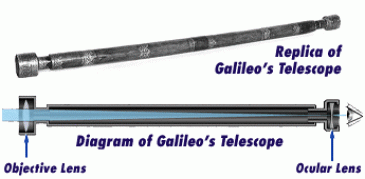
Galileo Telescope Replica, Invented about 1609, with 20X Power
Science instruments help scientists to apply the scientific method of inquiry to discover and reveal the material world. Galileo pioneered in telescope design and use and Leeuwenhoek fashioned the first microscope.
Telescopes permit astronomers to see distant planets, moons and stars closer as they are magnified and reveal their features. Microscopes magnify minute things, that are very close but very small, and microscopes enlarge and permit the unseen to be seen.
Both microscopes and telescopes use glass lenses. Both instruments bend light in unique ways to cause things to become bigger and larger so that they may be seen. Two scientists who did this were Galileo, who used one of the first telescopes, and Leeuwenhoek who crafted and designed the first microscope.
Telescopes permit astronomers to see distant planets, moons and stars closer as they are magnified and reveal their features. Microscopes magnify minute things, that are very close but very small, and microscopes enlarge and permit the unseen to be seen.
Both microscopes and telescopes use glass lenses. Both instruments bend light in unique ways to cause things to become bigger and larger so that they may be seen. Two scientists who did this were Galileo, who used one of the first telescopes, and Leeuwenhoek who crafted and designed the first microscope.
Lenses for Telescopes and Microscopes, Refractive and Reflective (Mirror) Lenses
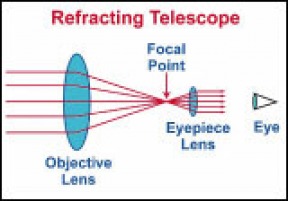
Telescope Lens Refracting Light
Seeing is believing, and soon the early science tools of astronomy and biology (microbiology) made what was too far, or too small, to become visible —telescopes for the far away stars and planets, and microscopes for the smallest of life, the bacteria — become more clearly visible indeed. Both the telescope and the microscope use the refractive properties of lenses to form images. Proper focal distances and adjustments are made in both instruments so that the enlarged image of the objective lens is again enlarged by the eyepiece lens. Astronomy is the science of stars far and near (earth's sun), earth's moon and many other moons of planets, dark holes, and the theories that attempt to explain the origin of the universe such as "the big bang theory."
Galileo Telescopes Humankind's Eyes to the Planets and the Sun
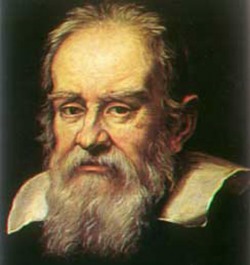
Galileo Great Astronomer and Physicist
Galileo Galilei (1564 to 1642 A.D.) used the discovery of an optician from Holland (Netherlands) who had shaped glass to make distant objects appear enlarged.
Galileo Made his own Refracting Telescope, and Discovered that:
1. earth's moon had craters;
2. planet Jupiter had at least 4 moons;
3. the sun had spots;
4. planet Venus had moon-like phases; and
5. earth revolved around the sun.
Galileo confirmed and proved that both Aristarchus and Copernicus were correct in the hypothesis that this was a solar-centric earth and planetary system.
Therefore, Galileo's observations were re-affirming that the sun, not the earth, was the center of this solar system. The Inquisition of the Roman Catholic Church made Galileo recant, and recently the Roman Catholic Church forgave Galileo, admitted his science was correct, and affirmed that science and theology do not conflict on this issue. That was an important statement for the church to make.
Discuss the significance and the meaning of Galileo as to the role of science, philosophy and religion. Compare and contrast the role and function of each discipline. Define each area of study.
Galileo Made his own Refracting Telescope, and Discovered that:
1. earth's moon had craters;
2. planet Jupiter had at least 4 moons;
3. the sun had spots;
4. planet Venus had moon-like phases; and
5. earth revolved around the sun.
Galileo confirmed and proved that both Aristarchus and Copernicus were correct in the hypothesis that this was a solar-centric earth and planetary system.
Therefore, Galileo's observations were re-affirming that the sun, not the earth, was the center of this solar system. The Inquisition of the Roman Catholic Church made Galileo recant, and recently the Roman Catholic Church forgave Galileo, admitted his science was correct, and affirmed that science and theology do not conflict on this issue. That was an important statement for the church to make.
Discuss the significance and the meaning of Galileo as to the role of science, philosophy and religion. Compare and contrast the role and function of each discipline. Define each area of study.
Simple Reflecting Telescope, Captures Low Light Intensity and Magnifies
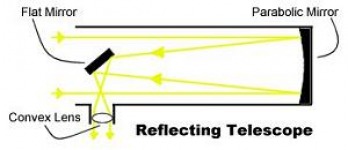
Reflecting Telescope Type, First Invented in 1671 by Newton
The reflecting telescope was invented in 1671, almost 60 years after Galileo's refracting telescopes. Galileo-type telescopes became very large and cumbersome — some were over 120 feet long.
Isaac Newton designed the reflecting telescope to gather light via a parabolic mirror. The parabolic mirror reflected that light onto a flat mirror which finally reflected that light into a convex lens to obtain an image. When working properly, the reflecting telescope is a very sensitive instrument for astronomy, and it works well under low light intensity. Modern telescopes use Isaac Newton's concept designs to contruct the most powerful telescopes used today.
Isaac Newton designed the reflecting telescope to gather light via a parabolic mirror. The parabolic mirror reflected that light onto a flat mirror which finally reflected that light into a convex lens to obtain an image. When working properly, the reflecting telescope is a very sensitive instrument for astronomy, and it works well under low light intensity. Modern telescopes use Isaac Newton's concept designs to contruct the most powerful telescopes used today.
Hubble Space Telescope - Most Advanced Telescope Known and Earth's Eyes in Space
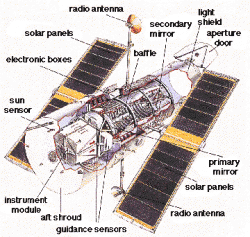
The Hubble Telescope was launched into space April 25, 1990. The year 2010, marks the 2oth anniversary of successful space observations. The Hubble telescope is actauuly a very complete and full observatory that gathers visible, near-ultraviolet and near-infrared light spectra unimpeded by earth's atmosphere because the telescope is positioned above the atmosphere. The Hubble Space Telescope gathers small amounts of the various radiations with great precision, and has provided astronomers with the best images of the cosmos ever seen.
Read more on the Hubble Telescope structure, functions, facts, and images.
VISIT Our Science Super School Store
All the Written Material within Site is Copyrighted 2010 and Owned by Dr. Donald Reinhardt, and this original material is protected legally by this copyright notice and by the Digital Millennium Act. None of this original material may be copied or reproduced without the expressed written consent of the author.
The author is a Freelance Science writer, and is available for specific assignments for those who are interested – by contacting adminstrator@sciencesuperchool.com. Other questions related to this teaching site should be directed to teacher@sciencesuperschool.com.
Read more on the Hubble Telescope structure, functions, facts, and images.
VISIT Our Science Super School Store
All the Written Material within Site is Copyrighted 2010 and Owned by Dr. Donald Reinhardt, and this original material is protected legally by this copyright notice and by the Digital Millennium Act. None of this original material may be copied or reproduced without the expressed written consent of the author.
The author is a Freelance Science writer, and is available for specific assignments for those who are interested – by contacting adminstrator@sciencesuperchool.com. Other questions related to this teaching site should be directed to teacher@sciencesuperschool.com.